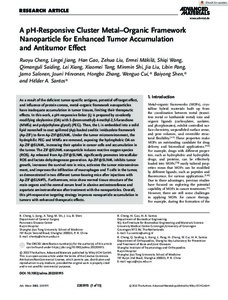A pH-Responsive Cluster Metal-Organic Framework Nanoparticle for Enhanced Tumor Accumulation and Antitumor Effect
Liu Zehua; Gao Han; Jiang Lingxi; Cheng Ruoyu; Shi Minmin; Mäkilä Ermei; Shen Baiyong; Zhang Hongbo; Pang Libin; Tang Xiaomei; Xiang Lei; Salonen Jarno; Saiding Qimanguli; Santos Hélder A.; Wang Shiqi; Cui Wenguo; Liu Jia; Hirvonen Jouni
https://urn.fi/URN:NBN:fi-fe2022102463090
Tiivistelmä
As a result of the deficient tumor-specific antigens, potential off-target effect, and influence of protein corona, metal–organic framework nanoparticles have inadequate accumulation in tumor tissues, limiting their therapeutic effects. In this work, a pH-responsive linker (L) is prepared by covalently modifying oleylamine (OA) with 3-(bromomethyl)-4-methyl-2,5-furandione (MMfu) and poly(ethylene glycol) (PEG). Then, the L is embedded into a solid lipid nanoshell to coat apilimod (Ap)-loaded zeolitic imidazolate framework (Ap-ZIF) to form Ap-ZIF@SLN#L. Under the tumor microenvironment, the hydrophilic PEG and MMfu are removed, exposing the hydrophobic OA on Ap-ZIF@SLN#L, increasing their uptake in cancer cells and accumulation in the tumor. The ZIF@SLN#L nanoparticle induces reactive oxygen species (ROS). Ap released from Ap-ZIF@SLN#L significantly promotes intracellular ROS and lactate dehydrogenase generation. Ap-ZIF@SLN#L inhibits tumor growth, increases the survival rate in mice, activates the tumor microenvironment, and improves the infiltration of macrophages and T cells in the tumor, as demonstrated in two different tumor-bearing mice after injections with Ap-ZIF@SLN#TL. Furthermore, mice show normal tissue structure of the main organs and the normal serum level in alanine aminotransferase and aspartate aminotransferase after treatment with the nanoparticles. Overall, this pH-responsive targeting strategy improves nanoparticle accumulation in tumors with enhanced therapeutic effects.
Kokoelmat
- Rinnakkaistallenteet [19207]
